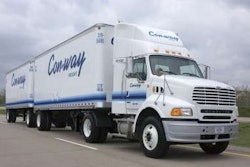Carriers may have to rethink their competition
Many shippers are responding to the drop in freight volumes – down more than 10 percent this year, according to the American Trucking Associations – by surgically cutting their number of partner carriers.
By working with fewer carriers, shippers speak of forming strategic partnerships, but what they really have in mind is asking for lower freight rates in exchange for more exclusive relationships.
Another result of low freight volumes is that shippers and manufacturers that operate private fleets are putting more freight on their own trucks to cover their fixed fleet costs. In some instances, shippers are collaborating to coordinate shipping schedules to run their private and dedicated fleets between facilities to share the cost savings.
I recently spoke with one shipper who is looking to put more freight on private fleets operated by its customers and suppliers to cut costs, create publicity and generate goodwill.
The net result of these and other strategic maneuvers is less freight for the small and even mid-size carrier. Now, more than ever, smaller carriers will have to be more competitive to retain market share.
In today’s economy, staying competitive requires carriers to offer low-cost and flexible transportation services in the markets they serve. Going forward, success may depend on whether a fleet can change its corporate vision to one that views its competition as potential partners.
On March 1, Lakeville Motor Express and Averitt Express opened a “hybrid” service center in Chicago. LME employees are onsite at the same facilities with their counterparts from Averitt to coordinate all pickup, delivery and linehaul operations for their respective customers. This is one of several reasons why CCJ selected LME as its 2009 Innovator of the Year (see page 52).
Teaming up with Averitt is “a fantastic use of operational resources,” says Al Bucher, LME executive vice president. “Since we were already serving many of the same customers, both of us will be more productive.”
The current economic challenges may cause more businesses – particularly small and mid-size carriers – to look for similar opportunities to form partnerships to retain and grow market share by improving their utilization and profitability.
Many truckload shipments are pieced together with stopoffs according to drivers’ hours-of-service schedules. In the past, truckload carriers usually turned down loads with multiple drops or priced them too high to be competitive.
To go after this more difficult category of freight, a truckload carrier could coordinate its schedules with a regional LTL carrier to drop its loaded and empty trailers at the LTL carrier’s facilities. The LTL carrier could handle the dropoffs and pickups for the truckload carrier in exchange for the truckload carrier taking linehaul moves outside its territory.
Truckload carriers also could look for partnership opportunities with other truckload carriers to create driver pools to avoid layovers. If one carrier had only enough drivers and freight to keep equipment moving for 11 to 12 hours a day, it could partner with carriers stationed in its layover zones to make its pickups and deliveries – either by leasing drivers or by dropping its trailers and paying for shuttle services.
With an ample supply of qualified drivers looking for work, carriers could run more team operations and hire more part-time “utility” drivers to better utilize equipment. Carriers could lease drivers from other carriers. In either case, utility drivers could be used to create two-shift schedules or to operate equipment when the primary drivers are off on weekends or otherwise resetting their hours-of-service clocks.
Increasingly, the revenue from “primary” fleet operations is barely enough to cover the fixed costs associated with equipment and overhead. More of these “secondary” operations – which may be possible only by partnering rather than competing with other carriers – may be where more carriers will be able to turn a profit.













